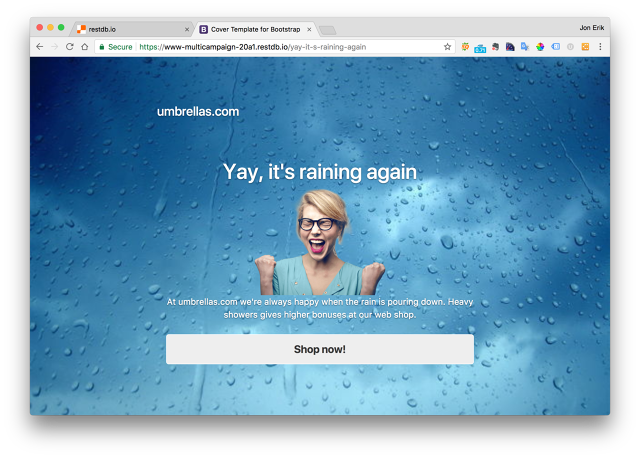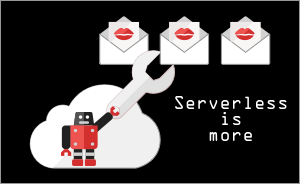Single page applications frameworks (SPA) are at the center stage of modern web development. Top notch web applications depends on fast and responsive behaviour in both user interface and data. Hence the popularity of frameworks like React, Angular, Vue and Ember.
This blog post shows how you can get started with React and restdb.io for development of applications with realtime data.
React is an amazing piece of technology. With it's realtime DOM manipulation and component thinking, it's just a perfect match for realtime enabled databases and frameworks like Firebase, RethinkDB, Pusher and RestDB.io.
In this blog post we'll be developing an application for displaying Nasdaq stock information.
RestDB recently announced support for developing client side Javascript plugins. Plugins lets you override and enhance existing functions in your database admin application.
Plugins are perfect tools to enrich and improve your data admin user interface with custom widgets and new functionality.
In this tutorial we'll show how you can create a Google Maps plugin widget. The plugin will display a map of a particular street address in a database.
The final result will look something like the screenshot below:

A spreadsheet is a genious invention with many uses. It is often considered the application that turned the microcomputer from a hobby for computer enthusiasts into a serious business tool. It's an awesome way to work with tabular data and to do calculations and visualize data.
Another very common use of spreadsheets is to store business data. "I created a spreadsheet with our customers and suppliers and uploaded it to Sharepoint". "I put the sales leads in a spreadsheet and shared it with you on Google Docs". These types of quick-fix spreadsheets slowly becomes permanent and starts to proliferate quickly, leading to a situation referred to as "Excel-Hell".
In many cases, the remedy for "Excel-Hell" is a database. In this article we provide an easy to follow walkthrough for transferring your spreadsheet "systems" into a modern cloud database.

Using a NoSQL document database (or SQL for that matter), it is quite easy to create a structure to organise this type of information; for each record/document/node, you simply need a reference to the parent (except for the top node).
So what's the problem?
The main problem is that querying and retrieving the whole or parts of the hierarchy will require complex code with recursion and an unknown number of queries which can put a big load on our database. Ouch!
In this blog post we will walk through a simple solution which lets you retrieve any (or all) parts of a hierarchy (a threaded discussion) using only ONE efficient database query in restdb.io. To follow along, you can just create a new restdb database yourself. Everything is done online, you only need a modern browser.

We wanted to create a simple, developer friendly email campaign tool that we could use internally for our monthly newsletter at restdb.io (it's available as a database template you can play around with).
The requirements were these:
And last, but not least: Everything should be written using serverless Javascript, HTML and NoSQL.
Difficult? Yes. Doable? Certainly! Read on.
This blog post uses the classical Northwind example from Microsoft to show how you can migrate from a traditional relational database to a NoSQL cloud database.
Northwind Traders Access database is a sample database that shipped with Microsoft Office suite. The Northwind database contains the sales data for a fictitious company called Northwind Traders, which imports and exports specialty foods from around the world. Developers (back in the 90's 🙌) used it to learn the MS Access product.
In the following example we will show how to:
Engaging your audience is good for business. Whether your audience are users, subscribers, companies or hot leads, you should have an automated system for keeping them happy.
Sending personal emails based on user actions is an important tool in this aspect.
You can choose from a bunch of excellent email services (APIs) today, e.g. Sendgrid, Mailchimp, Mandrill, Mailgun, Amazon and Mailjet. But there are major challenges in first grasping, and then integrate and automate these services into your application.
This blog post shows how you can automate sending of transactional email directly from a restdb.io application. No need to setup or integrate anything. There is a link to an installable template at the end of the article to get you up to speed quickly.
In your career as developer you've probably at some time felt guilty when the project manager asked you where the documentation is. "It's a self-documenting system", you say, trying to be smart.
What if there was a fun and simple way to write and share those docs? For all your (development) projects?
In this blogpost we'll show you how the DocHUB database template was created. It provides an easy way to create dynamic project documentation with Markdown using a restdb.io database as the content engine and the amazing Flatdoc for displaying and navigating the docs with a little Javascript magic.
The template has been very popular and has been installed many times by our users. If you're not into coding, you can of course just install it and use it as is. Otherwise, read on (and learn).

You desperately need some automagical way to limit collection sizes to contain only relevant data, and chop off garbage data.
Relax, this is exactly what you can accomplish with a background JavaScript that caps collection data to a specific limit.
This blog post will show you how.
We'll soon be entering 2017. And Email is still around.
This blog post shows how you can use a "serverless" Javascript Codehook to send email to people from a web page.
In this example you’ll learn how to use:
Are you ready to learn some fun and useful stuff?
Crontab is a well known workhorse from the Unix and Linux world.
The crontab is a system that lets you run commands on a regular schedule. Crontab stands for “cron table”, because it uses the job scheduler cron to execute tasks; cron itself is named after “chronos,” the Greek word for time.
Using the Crontab system, restdb.io can invoke a Codehook. A Codehook is a JavaScript function that can access your database or any other network resource.
Combining Crontab and Codehooks puts you in control. It lets you build a more versatile and advanced data backend for your application.
This blog post shows how to get started creating your own Crontab jobs in restdb.io.
Native apps for IOS and Android provide developers with options, performance and styling beyond the capabilities of the browsers. Up until recently, however, this meant learning and dealing with bespoke programming languages and SDKs. Fortunately, react-native have come to the rescue, offering a familiar JavaScript programming and standardized components for the major platforms.
Building a fully functional react-native app with persistence and authentication is surprisingly easy. Using restdb.io for cloud hosted data and Auth0 for user authentication, you get lots of features right out of the box. Follow the steps in this post and you’ll be up and running in no time.

The new restdb.io feature, Codehooks, lets you execute JavaScripts directly in your database.
This feature opens up an array of cool scenarios for your application. One of them is to integrate your database with slack.com.
Slack seems to be every team’s favorite collaboration platform now. If you’re not using this great tool already, I would suggest you give it a try. It can practically eliminate the need for sending internal (non-important) emails, and introduces a more human touch to your team information flow.
That’s why it makes sense to let your database talk to Slack, instead of you logging on to your database admin, all the time, to see what’s going on.
This blog post shows you how you can create a JavaScript Codehook to feed your Slack with important stuff that happens inside your database.

We will show how you can use a pre-made restdb.io database template to create your own DevOps server monitoring dashboard with JavaScript, Google Charts and Bash shell scripts. The setup is simple and will only take you a few minutes to try out.

